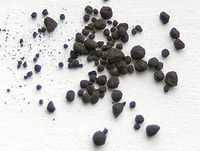Palladium(II) oxide
 | |
| Names | |
|---|---|
| Other names
Palladium monoxide | |
| Identifiers | |
| 1314-08-5 | |
| ChemSpider | 66602 |
| |
| Jmol-3D images | Image |
| PubChem | 73974 |
| |
| Properties | |
| PdO | |
| Molar mass | 122.42 g/mol |
| Appearance | greenish-black powder |
| Density | 8.3 g/cm3 |
| Melting point | 750 °C (1,380 °F; 1,020 K) decomposes |
| insoluble | |
| Solubility | insoluble in acid slightly soluble in aqua regia |
| Hazards | |
| EU Index | Not listed |
| Flash point | Non-flammable |
| Related compounds | |
| Other anions |
Palladium sulfide |
| Other cations |
Nickel(II) oxide |
| Except where noted otherwise, data is given for materials in their standard state (at 25 °C (77 °F), 100 kPa) | |
| | |
| Infobox references | |
Palladium(II) oxide is the inorganic compound of formula PdO. It is the only well characterised oxide of palladium.[1] It is prepared by treating the metal with oxygen. Above about 900 °C, the oxide reverts to palladium metal and oxygen gas. It is not attacked by acids.[1]
Preparation
PdO is often obtained as a poorly defined material that is generated for applications as a catalyst (see Adams catalyst). Palladium oxide is prepared by heating palladium sponge in oxygen at 350 °C.
- 2 Pd + O2 → 2 PdO
The oxide is obtained as a black powder. The oxide also may be prepared specially for catalytic use by heating variously a mixture of palladium(II) chloride and potassium nitrate,
- 2 PdCl2 + 4 KNO3 → 2 PdO + 4 KCl + 2 NO2 + O2 (possible reaction)
or the product of dissolving palladium in aqua regia, followed by the addition of sodium nitrate at 600 °C.[2][3] A hydrated form of the oxide (which dissolves in acid) can be prepared by precipitation from solution, for example, by hydrolysis of palladium nitrate or reaction of a soluble palladium compound with a strong base. The brown hydrated oxide converts to black anhydrous oxide on heating. Its susceptibility to attack by acids decreases at lower water content.
The hydrated oxide (hydroxide), PdO.nH2O can be produced as a dark-yellow precipitate by adding alkali to a solution of palladium nitrate, Pd(NO3)2.[1]
Applications
Materials called palladium oxide are useful catalysts for catalytic hydrogenation in organic synthesis.[2]
References
- ↑ 1.0 1.1 1.2 Greenwood, Norman N.; Earnshaw, Alan (1984). Chemistry of the Elements. Oxford: Pergamon Press. pp. 1336–37. ISBN 0-08-022057-6.
- ↑ 2.0 2.1 Donald Starr and R. M. Hixon (1943). "Tetrahydrofuran". Org. Synth.; Coll. Vol. 2, p. 566
- ↑ Handbook of Preparative Inorganic Chemistry, 2nd Ed. Edited by G. Brauer, Academic Press, 1965, NY. Vol. 2. p. 1583.
| ||||||||||||||||||||||